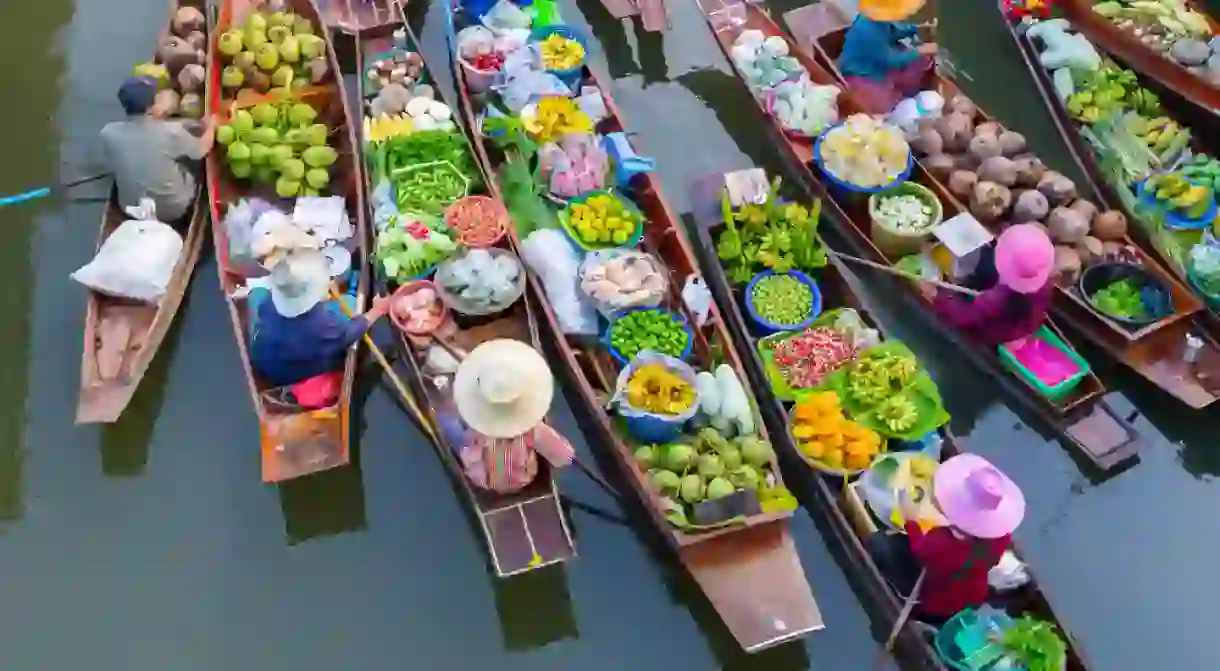An Introduction To Thailand's Floating Markets

One might feel as though they are entering a different world upon visiting a Thai floating market. Slender canals are crammed with boats selling an abundance of food and goods, while friendly vendors talk amongst themselves in Thai. While some countries in Asia have their own floating markets, none compare to Thailand’s, and the surreal experience is one you cannot miss while visiting the country. Here, we tell you everything you need to know about Thailand’s famous floating markets.
History
Floating markets are mainly found in Thailand, Indonesia and Vietnam. Floating markets today are essentially tourist traps, with alluring food and souvenirs. They did not always use to be this way, however. The Chao Phraya River that weaves through Bangkok is often referred to as the artery of the city. The water was a way a life for people in Thailand, making it possible for them to travel and sell their goods. Before urban Bangkok was developed, the city was a jungle, making it almost impossible for vendors and sellers alike to make any money off their goods. These goods were sold both regionally and internationally on these waterways. Even when Thai people saw the creation of roads and different means of transportation throughout the city, the canals remained a popular means of trade. This is the case for waterways throughout Thailand.
Damnoen Saduak Floating Market
There are many floating markets in Bangkok, and the most popular one is the Damnoen Saduak Floating Market. This market is usually bursting with tourists, which is never a good thing. Regardless, the Damnoen Saduak Floating Market definitely deserves a spot on your travel itinerary. The market is about an hour outside of Bangkok. You can book a tour to visit and explore the market for an entire day. You will want to arrive early, as the bulk of people start to show up at around 9am. Arriving at 7am is ideal. Most tour itineraries include transfer to and from your accommodation. Some even include long-tail boat rides down the canals where the floating market is. It is a great way to see the winding canals you would not otherwise have access to on foot, including remote villages and plantations.
Bang Kachao
Bang Kachao is often referred to as ‘Bangkok’s Green Lung.’ It is about six miles away from downtown Bangkok. Shaded by papaya groves and coconut trees, many visit this island-like oasis for its great cycling paths. This is also where you will find the Talad Nam Peung Floating Market, sometimes referred to as the honey market. It is significantly less touristy than Damnoen Saduak Floating Market, and also much easier to get to. Here, you will find organic produce, delicious market food and more. Visitors can also rent a boat of their own to explore these canals solo.
Amphawa Floating Market
Amphawa Floating Market is Bangkok’s second most popular floating market, located about 50 kilometers outside of the city. While it does still see its fair share of tourists, it is not as crowded as Damnoen Saduak Floating Market. Most people who visit this market are Thai, making it that much more authentic. This market is famous for its seafood, with wooden boats filled with everything from shellfish to squid.
When To Go
Most floating markets are only open on the weekends. To beat the throngs of tourists, the best time to go is before lunchtime, when the majority of visitors show up. Ideally, head there early in the morning.













